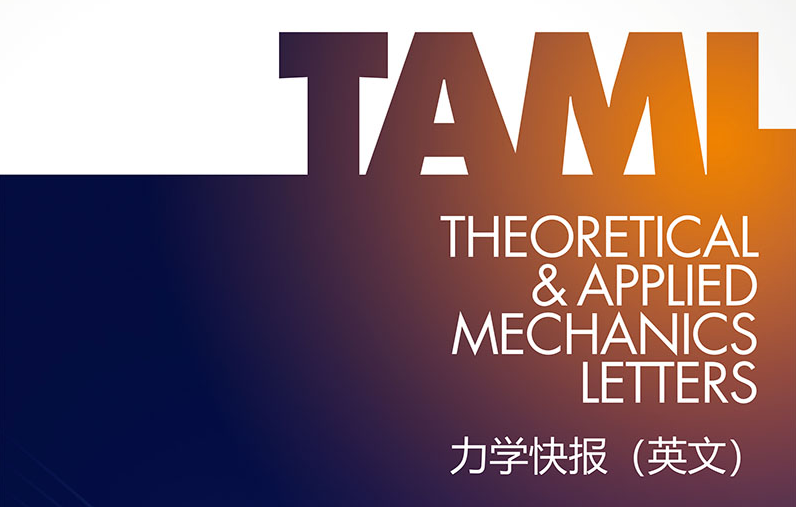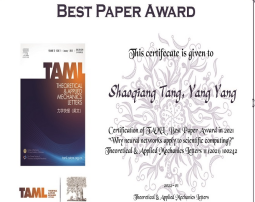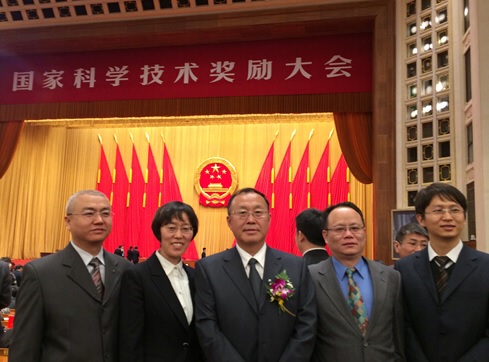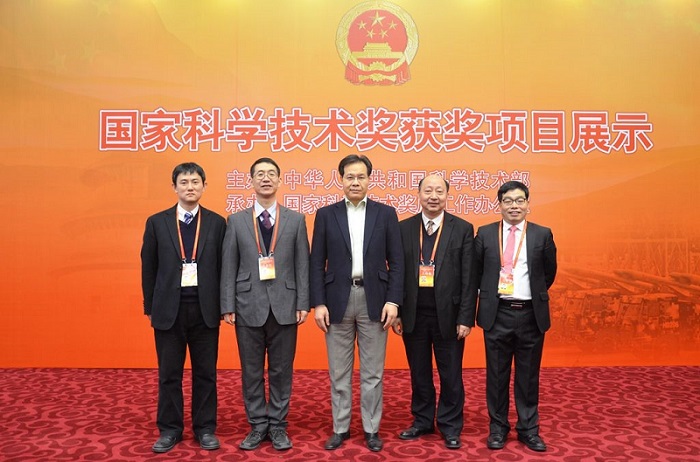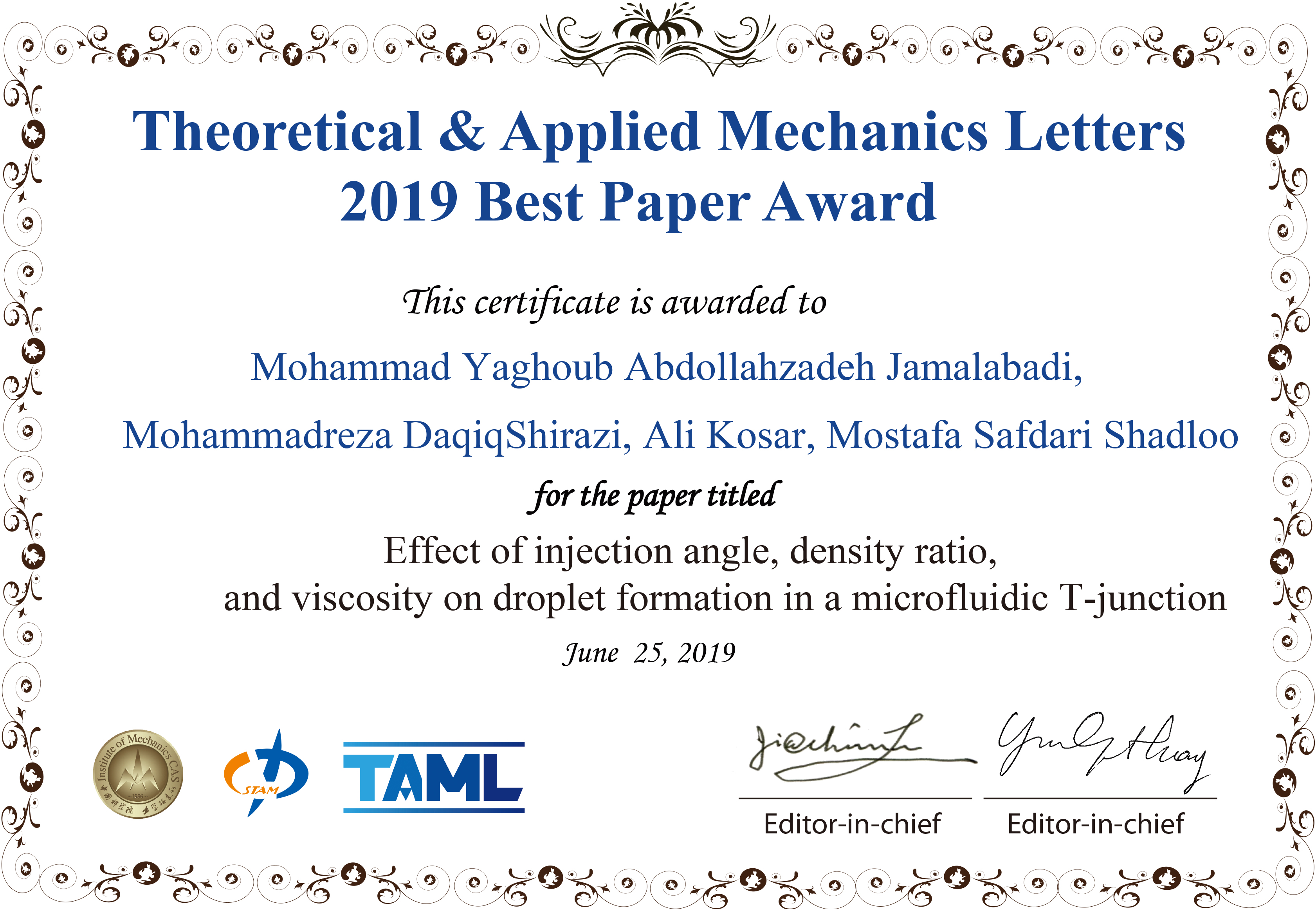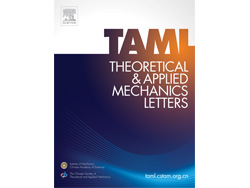Institute of Mechanics,
Chinese Academy of Sciences
2024 Vol.14(5)
Display Mode: |
Theoretical and Applied Mechanics Letters 14 (2024) 100537.
doi: 10.1016/j.taml.2024.100537
Abstract:
To improve the passive safety of high-speed trains, it is very important to understand the mechanism of head injury in high-speed train collisions. In this study, the head injury mechanisms of occupants in high-speed train rear-end collisions were investigated based on the occupant-seat coupling model, which included a dummy representing the Chinese 50th percentile adult male. The typical injury responses in terms of skull fractures, brain contusions, and diffuse axonal injury (DAI) were analyzed. Meanwhile, the influences of collision speed and seat parameters on head injury response were examined. The simulation results indicate that the skull fractures primarily occur at the skull base region due to excessive neck extension, while the brain contusions and DAI result from the relative displacement of different brain regions. The increase in collision speed will promote the probability of skull fracture, brain contusion, and DAI. Seat design modifications, such as reduced seat spacing, increased seat backrest angles, and selecting the appropriate cushion angle (76°) and friction coefficient (0.15), can effectively mitigate probably occupant's head injury.
To improve the passive safety of high-speed trains, it is very important to understand the mechanism of head injury in high-speed train collisions. In this study, the head injury mechanisms of occupants in high-speed train rear-end collisions were investigated based on the occupant-seat coupling model, which included a dummy representing the Chinese 50th percentile adult male. The typical injury responses in terms of skull fractures, brain contusions, and diffuse axonal injury (DAI) were analyzed. Meanwhile, the influences of collision speed and seat parameters on head injury response were examined. The simulation results indicate that the skull fractures primarily occur at the skull base region due to excessive neck extension, while the brain contusions and DAI result from the relative displacement of different brain regions. The increase in collision speed will promote the probability of skull fracture, brain contusion, and DAI. Seat design modifications, such as reduced seat spacing, increased seat backrest angles, and selecting the appropriate cushion angle (76°) and friction coefficient (0.15), can effectively mitigate probably occupant's head injury.
Investigation on flight load calibration of aircraft composite wing base on strain gauge measurement
Theoretical and Applied Mechanics Letters 14 (2024) 100540.
doi: 10.1016/j.taml.2024.100540
Abstract:
A computational and test method for calibrating the flight loads carried by aircraft wings is proposed. The wing load is measured in real-time based on the resistance and fiber Bragg grating strain gauges. The linear stepwise regression method is used to construct the load equations. The mean impact value algorithm is employed to select suitable bridges. In the ground calibration experiment, the wing load calculation equations in both forward and reverse installation states are calibrated. The correctness of the load equations was verified through equation error and inspection error analysis. Finally, the actual flight load of the wing was obtained through flight tests.
A computational and test method for calibrating the flight loads carried by aircraft wings is proposed. The wing load is measured in real-time based on the resistance and fiber Bragg grating strain gauges. The linear stepwise regression method is used to construct the load equations. The mean impact value algorithm is employed to select suitable bridges. In the ground calibration experiment, the wing load calculation equations in both forward and reverse installation states are calibrated. The correctness of the load equations was verified through equation error and inspection error analysis. Finally, the actual flight load of the wing was obtained through flight tests.
Theoretical and Applied Mechanics Letters 14 (2024) 100550.
doi: 10.1016/j.taml.2024.100550
Abstract:
To enhance the protective performance of ceramic composite armor, ballistic penetration experiments were conducted on Al2O3 ceramic-ultra-high molecular weight polyethylene (UHMWPE) composite armor with different thickness configurations. The damage and failure modes of hard projectiles and ceramic-fiber composite targets were analyzed. The recovered projectiles and ceramic fragments were sieved and weighed at multiple stages, revealing a positive correlation between the degree of fragmentation of the projectiles and ceramics and the overall ballistic resistance of the composite targets. Numerical simulations were performed using the LS-DYNA finite element software, and the simulation results showed high consistency with the experimental results, confirming the validity of the material parameters. The results indicate that the projectile heads primarily exhibited crushing and abrasive fragmentation. Larger projectile fragments mainly resulted from tensile and shear stress-induced failure. The failure modes of the composite targets included the formation of ceramic cones and radial cracks under high-velocity impacts. The UHMWPE laminated plates exhibited interlayer separation caused by tensile waves, permanent plastic deformation of the rear surface bulging, and perforation failure primarily due to shear forces.Through extended numerical simulations, while maintaining the same areal density and configuration of 9 mm Al2O3 ceramic +12 mm UHMWPE laminated composite armor, the thickness configurations of the Al2O3 ceramic and UHMWPE laminated backplates were varied, and various thicknesses of UHMWPE laminates were simulated as the cover layer for the ceramic panels. The simulation results indicated that the composite armor configuration of 10 mm Al2O3 ceramic + 8 mm UHMWPE composite armor increased energy absorption by 13.48%. When altering the cover layer thickness, a 4 mm UHMWPE + 9 mm Al2O3 + 8 mm UHMWPE composite armor demonstrated a 27.11% improvement in energy absorption, showing a relatively significant enhancement.
To enhance the protective performance of ceramic composite armor, ballistic penetration experiments were conducted on Al2O3 ceramic-ultra-high molecular weight polyethylene (UHMWPE) composite armor with different thickness configurations. The damage and failure modes of hard projectiles and ceramic-fiber composite targets were analyzed. The recovered projectiles and ceramic fragments were sieved and weighed at multiple stages, revealing a positive correlation between the degree of fragmentation of the projectiles and ceramics and the overall ballistic resistance of the composite targets. Numerical simulations were performed using the LS-DYNA finite element software, and the simulation results showed high consistency with the experimental results, confirming the validity of the material parameters. The results indicate that the projectile heads primarily exhibited crushing and abrasive fragmentation. Larger projectile fragments mainly resulted from tensile and shear stress-induced failure. The failure modes of the composite targets included the formation of ceramic cones and radial cracks under high-velocity impacts. The UHMWPE laminated plates exhibited interlayer separation caused by tensile waves, permanent plastic deformation of the rear surface bulging, and perforation failure primarily due to shear forces.Through extended numerical simulations, while maintaining the same areal density and configuration of 9 mm Al2O3 ceramic +12 mm UHMWPE laminated composite armor, the thickness configurations of the Al2O3 ceramic and UHMWPE laminated backplates were varied, and various thicknesses of UHMWPE laminates were simulated as the cover layer for the ceramic panels. The simulation results indicated that the composite armor configuration of 10 mm Al2O3 ceramic + 8 mm UHMWPE composite armor increased energy absorption by 13.48%. When altering the cover layer thickness, a 4 mm UHMWPE + 9 mm Al2O3 + 8 mm UHMWPE composite armor demonstrated a 27.11% improvement in energy absorption, showing a relatively significant enhancement.
Theoretical and Applied Mechanics Letters 14 (2024) 100551.
doi: 10.1016/j.taml.2024.100551
Abstract:
The elastodynamic dislocation behaviors are of great interest for understanding the performances of structural alloys under intense dynamic loading conditions. The formation, propagations, and interactions of dislocations (such as injected dislocation, accelerating dislocation, steady moving dislocation at high constant speed) are quite different from static dislocations. For steady-moving dislocation within the isotropic infinite medium, the effects of surface and interface on steady-moving dislocations within limited space are still known. In this paper, we investigate the elastodynamic image stress simulation of steady moving dislocation within film of limited thickness at constant speed using Eigenstrain theory, Lorentz transformation, and steady dynamic equilibrium equations. We propose an efficient solution method that involves complex Fourier series, transforming partial differential equations into ordinary differential equations, and ultimately into a set of algebraic equations in spectral space. The effects of dislocation speed and position near the free surface on the image stress of steady-moving climbing and gliding dislocations within the thin film are examined. The results show that relativistic effects are significant for certain dislocation configurations and stress components, whereas other stress components are less sensitive to relativistic effects near the transonic speed region.
The elastodynamic dislocation behaviors are of great interest for understanding the performances of structural alloys under intense dynamic loading conditions. The formation, propagations, and interactions of dislocations (such as injected dislocation, accelerating dislocation, steady moving dislocation at high constant speed) are quite different from static dislocations. For steady-moving dislocation within the isotropic infinite medium, the effects of surface and interface on steady-moving dislocations within limited space are still known. In this paper, we investigate the elastodynamic image stress simulation of steady moving dislocation within film of limited thickness at constant speed using Eigenstrain theory, Lorentz transformation, and steady dynamic equilibrium equations. We propose an efficient solution method that involves complex Fourier series, transforming partial differential equations into ordinary differential equations, and ultimately into a set of algebraic equations in spectral space. The effects of dislocation speed and position near the free surface on the image stress of steady-moving climbing and gliding dislocations within the thin film are examined. The results show that relativistic effects are significant for certain dislocation configurations and stress components, whereas other stress components are less sensitive to relativistic effects near the transonic speed region.
Theoretical and Applied Mechanics Letters 14 (2024) 100552.
doi: 10.1016/j.taml.2024.100552
Abstract:
Fatigue properties play a crucial role as they are vital to ensuring the durability and integrity of components subjected to repeated loading conditions over long periods. The main objective of this work is to investigate the fatigue behavior of dual phase low-carbon steels used in automotive applications using a rotating bending fatigue machine. Heat treatments were carried out to analyze the microstructure's effect on the fatigue properties, including quenching low-carbon steel samples at 800 °C and 900 °C. Hardness and tensile tests were performed, and the microstructure was inspected to examine the constitute phases. With the assistance of a scanning electron microscope, fractographic analyses were carried out to reveal the fracture features of the samples at different lifetime ranges. The results show that various failure mechanisms occur depending on the stress levels. Additionally, the specimens quenched at 900 °C exhibited higher fatigue strength.
Fatigue properties play a crucial role as they are vital to ensuring the durability and integrity of components subjected to repeated loading conditions over long periods. The main objective of this work is to investigate the fatigue behavior of dual phase low-carbon steels used in automotive applications using a rotating bending fatigue machine. Heat treatments were carried out to analyze the microstructure's effect on the fatigue properties, including quenching low-carbon steel samples at 800 °C and 900 °C. Hardness and tensile tests were performed, and the microstructure was inspected to examine the constitute phases. With the assistance of a scanning electron microscope, fractographic analyses were carried out to reveal the fracture features of the samples at different lifetime ranges. The results show that various failure mechanisms occur depending on the stress levels. Additionally, the specimens quenched at 900 °C exhibited higher fatigue strength.
Theoretical and Applied Mechanics Letters 14 (2024) 100553.
doi: 10.1016/j.taml.2024.100553
Abstract:
This study demonstrates that two- and three-dimensional spatially graded, truss-based polymeric-material metamaterials can be designed for beneficial impact mitigation and energy absorption capabilities. Through a combination of numerical and experimental techniques, we highlight the broad property space of periodic viscoelastic trusses, realized using 3D printing via selective laser sintering. Extending beyond periodic designs, we investigate the impact response of spatially variant viscoelastic lattices in both two and three dimensions. Our result reveal that introducing spatial variations in lattice topology allows for redirecting of the impact trajectory, opening new opportunities for engineering and tailoring lightweight materials with target impact functionality. This is achieved through the combined selection of base material and metamaterial design.
This study demonstrates that two- and three-dimensional spatially graded, truss-based polymeric-material metamaterials can be designed for beneficial impact mitigation and energy absorption capabilities. Through a combination of numerical and experimental techniques, we highlight the broad property space of periodic viscoelastic trusses, realized using 3D printing via selective laser sintering. Extending beyond periodic designs, we investigate the impact response of spatially variant viscoelastic lattices in both two and three dimensions. Our result reveal that introducing spatial variations in lattice topology allows for redirecting of the impact trajectory, opening new opportunities for engineering and tailoring lightweight materials with target impact functionality. This is achieved through the combined selection of base material and metamaterial design.
Theoretical and Applied Mechanics Letters 14 (2024) 100543.
doi: 10.1016/j.taml.2024.100543
Abstract:
An intelligent wind tunnel using an active learning approach automates flow control experiments to discover the aerodynamic impact of sweeping jet on a swept wing. A Gaussian process regression model is established to study the jet actuator’s performance at various attack and flap deflection angles. By selectively focusing on the most informative experiments, the proposed framework was able to predict 3721 wing conditions from just 55 experiments, significantly reducing the number of experiments required and leading to faster and cost-effective predictions. The results show that the angle of attack and flap deflection angle are coupled to affect the effectiveness of the sweeping jet. Meanwhile, increasing the jet momentum coefficient can contribute to lift enhancement; a momentum coefficient of can increase the lift coefficient by at most 0.28. Additionally, the improvement effects are more pronounced when actuators are placed closer to the wing root.
An intelligent wind tunnel using an active learning approach automates flow control experiments to discover the aerodynamic impact of sweeping jet on a swept wing. A Gaussian process regression model is established to study the jet actuator’s performance at various attack and flap deflection angles. By selectively focusing on the most informative experiments, the proposed framework was able to predict 3721 wing conditions from just 55 experiments, significantly reducing the number of experiments required and leading to faster and cost-effective predictions. The results show that the angle of attack and flap deflection angle are coupled to affect the effectiveness of the sweeping jet. Meanwhile, increasing the jet momentum coefficient can contribute to lift enhancement; a momentum coefficient of can increase the lift coefficient by at most 0.28. Additionally, the improvement effects are more pronounced when actuators are placed closer to the wing root.
Theoretical and Applied Mechanics Letters 14 (2024) 100555.
doi: 10.1016/j.taml.2024.100555
Abstract:
Dynamic mode decomposition (DMD) aims at extracting intrinsic mechanisms in a time sequence via linear recurrence relation of its observables, thereby predicting later terms in the sequence. Stability is a major concern in DMD predictions. We adopt a regularized form and propose a Regularized DMD (ReDMD) algorithm to determine the regularization parameter. This leverages stability and accuracy. Numerical tests for Burgers’ equation demonstrate that ReDMD effectively stabilizes the DMD prediction while maintaining accuracy. Comparisons are made with the truncated DMD algorithm.
Dynamic mode decomposition (DMD) aims at extracting intrinsic mechanisms in a time sequence via linear recurrence relation of its observables, thereby predicting later terms in the sequence. Stability is a major concern in DMD predictions. We adopt a regularized form and propose a Regularized DMD (ReDMD) algorithm to determine the regularization parameter. This leverages stability and accuracy. Numerical tests for Burgers’ equation demonstrate that ReDMD effectively stabilizes the DMD prediction while maintaining accuracy. Comparisons are made with the truncated DMD algorithm.
Theoretical and Applied Mechanics Letters 14 (2024) 100534.
doi: 10.1016/j.taml.2024.100534
Abstract:
This study focuses on exploring the complex dynamical behaviors of a magnetic microrobot in a random environment. The purpose is to reveal the mechanism of influence of random disturbance on microrobot dynamics. This paper establishes stochastic dynamic models for the microrobot before and after deformation, considering the influence of Gaussian white noise. The system responses are analyzed via steady-state probability density functions and first deformation time. The effects of different magnetic field strengths and fluid viscosities on the movement speed and angular velocity of the microrobot are studied. The results indicate that random disturbances can cause deformation of microrobots in advance compared to the deterministic case. This work contributes to the design and motion control of microrobots and enhances the theoretical foundation of microrobots.
This study focuses on exploring the complex dynamical behaviors of a magnetic microrobot in a random environment. The purpose is to reveal the mechanism of influence of random disturbance on microrobot dynamics. This paper establishes stochastic dynamic models for the microrobot before and after deformation, considering the influence of Gaussian white noise. The system responses are analyzed via steady-state probability density functions and first deformation time. The effects of different magnetic field strengths and fluid viscosities on the movement speed and angular velocity of the microrobot are studied. The results indicate that random disturbances can cause deformation of microrobots in advance compared to the deterministic case. This work contributes to the design and motion control of microrobots and enhances the theoretical foundation of microrobots.
Theoretical and Applied Mechanics Letters 14 (2024) 100538.
doi: 10.1016/j.taml.2024.100538
Abstract:
Pilots’ ability is significantly improved by using night vision goggles and other equipment built on the flight helmets. Still, excessive helmet mass and centroid deviation caused by the integration of external equipment may increase the risk of neck injury of pilots during takeoff and landing. To reduce the risk of pilots’ neck injuries under impact load, it is urgent to study the law of related factors on pilot’s neck injury and provide theoretical support for the design of flight helmets. This paper establishes a finite element model of the pilot-seat-restraint system, and the effects of helmet masses, helmet centroids, and neck stress postures on the pilot’s neck injury are systematically studied. The function rules of these factors on the neck load are clarified. This research can provide an essential reference for designing and optimizing flying helmets.
Pilots’ ability is significantly improved by using night vision goggles and other equipment built on the flight helmets. Still, excessive helmet mass and centroid deviation caused by the integration of external equipment may increase the risk of neck injury of pilots during takeoff and landing. To reduce the risk of pilots’ neck injuries under impact load, it is urgent to study the law of related factors on pilot’s neck injury and provide theoretical support for the design of flight helmets. This paper establishes a finite element model of the pilot-seat-restraint system, and the effects of helmet masses, helmet centroids, and neck stress postures on the pilot’s neck injury are systematically studied. The function rules of these factors on the neck load are clarified. This research can provide an essential reference for designing and optimizing flying helmets.
 Submit a Paper
Submit a Paper
 Subscription
Subscription
News
MORE+
Call for Papers
MORE+
- Crossing-Mechanics Driven by Big Data
- Machine learning in the fluid mechanics research of wind energy
- Mechanics of Origami/Kirigami structures and metamaterials
- New insights and perspectives on impact biomechanics for human tissues: from injury prevention, protection to protective equipment
- Environmental Mechanics for Extreme Natural Events





